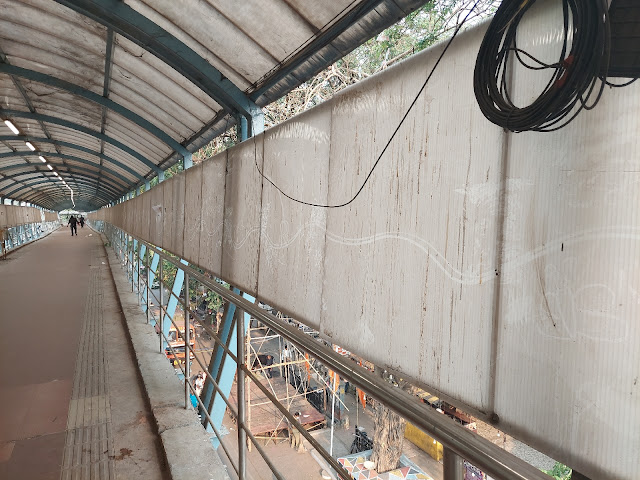Every morning, I pass by the Borivali West Sky-walk and there are versions of it that I observe, in different facets, occupancies, affordances and experiences. Earlier I have thought of sky-walk as a space of infrastructure, enterprise, landscape, home; and this time, it emerged to me as a museum.
With the rise in construction activity within the city given the beautification under the G20 summit, concrete dust, along with seasonal dust is rampant in the air. (Mumbai's air has recently been announced as one of the most polluted as compared to other cities in India; many people are suffering respiratory problems).
As we approach the summer after the festival of Holi, the wind becomes dry and carries fine particles of soil, sand, dust and cement. This gets settled onto the polycarbonate vision barriers installed on both sides of the sky-walk. As they wait to be cleared, by the corporation officials or the eventual rain, the thin layer of dust becomes a canvas for several passers by to instinctively sweep messages and patterns off their finger. Thus, the dust laden polycarbonate panels are filled with messages, drawings, patterns, of all kinds, becoming a soft canvas of/for the city.
In Shanghai, I had once observed an old man with a bucket of water and a large brush who painted poetry on the pathway of a public garden as an evening ritual. The yet-lukewarm stone of the garden held the liquid poetry for a little while until it evaporated into the air. The sheer sublimity of this performance triggered several thoughts in my mind - the economy of material, the public nature of the setting, the performance of poetry in space, the silence and surprise, the poise of paint and immediacy of the message, the body and the brush, the warmth and wetness - making it a profound work of art.
The dust boards here in Mumbai then, are a perfect solution to the high intensity transitory demand for communication in public space. They are temporary, light, low maintenance and ephemeral in a manner that not only serves purpose, but also are soft non-intrusive canvases that quietly assist you as you traverse through the sky-walk. Further, these now-information boards are completely public, free and open canvases for leaving messages without a cost. They allow for entrepreneurial information, moral messaging, missed connections, lost loves in combination with poetry, profanity, doodles or drawings that people make while waiting in the city. More importantly, they become spaces of self expression in the city.
Sophie Blackall, the Australian-American illustrator, in her work 'Missed Connections' accesses the archive of what-if love stories left by strangers whose eyes may or may not have met while transacting through the city, over internet platforms like Craigslist. Blackall summarises:
"Every day hundreds of strangers reach out to other strangers on the strength of a glance, a smile or a blue hat. Their messages have the lifespan of a butterfly. I’m trying to pin a few of them down.”
It is the aspect of pinning down a butterfly-message, and imagining its full life, that this post ought to do. The messages left on the dust-canvases of this suburban skywalk in Mumbai may then be a physical counterpart of the virtual notes on the internet portals, that Blackall illustrates so vividly. For the passer by, the sky-walk opens up as an archive of the city's desires. In its particular setting, where we encounter the dust-boards at the eye-level swiped with finger strokes, the sky-walk turns into no less than a museum displaying a long reel of urban graffiti - one that is going to disappear or extend or even overwritten without permission or prior notice, and this with no offence or promise to the author.
I hope the authorities never find this out, and allow for this play to remain on the surfaces of the sky-walk - as a marker of dust, desire and democracy that cultural spaces ought to attend with full attention.
















No comments:
Post a Comment